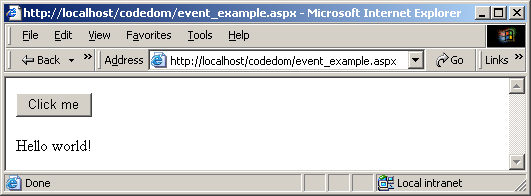
This example shows you how to use the code behind mechanism. It is the same program than the Event click example simply using the code behind mechanism.
Here we have an ASP page written in C# that references some code behind written in Eiffel. The code behind display or erase the message "Hello world!" in the label `my_lbl' when the button is clicked.
Note: Within an ASP page written in Eiffel, it is not possible to write any code behind also written in Eiffel.
<%@ Page Language="C#" inherits="BUTTON_EVENT" Src="button_event_code\button_event.e" %> <html> <body> <form runat=server> <asp:Button id=Button1 text="Click me" OnClick="button_click"; runat=server /> <br> <asp:Label runat=server text="" id=my_lbl /> </form runat=server> </body> <html>>
There are some rules you must follow in order to write a code behind class:
indexing description: "Code behind class of page code_behind.aspx" class BUTTON_EVENT inherit WEB_PAGE undefine finalize, get_hash_code, equals, to_string end ANY feature -- Access my_lbl: WEB_LABEL -- Label to display message when button is clicked. feature -- Basic Operation button_click (source: SYSTEM_OBJECT; e: EVENT_ARGS) is -- Action performed on button click do if my_lbl.text.length = 0 then my_lbl.set_text (("Hello world!").to_cil) else my_lbl.set_text (("").to_cil) end end end -- Class BUTTON_EVENT
Here is the output after one click on the button:
